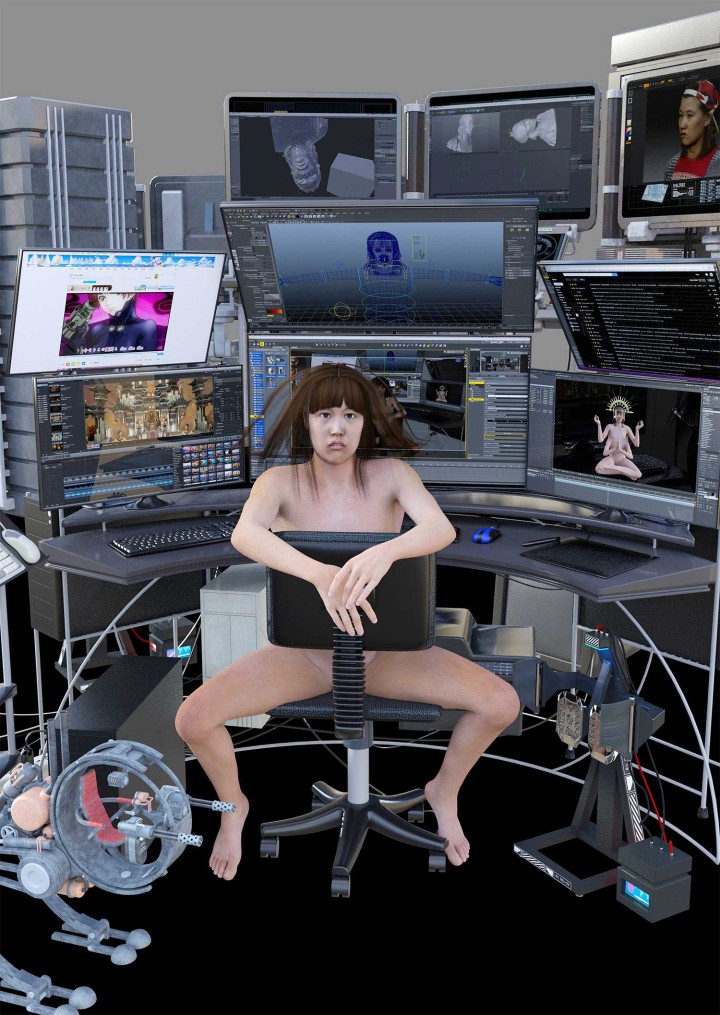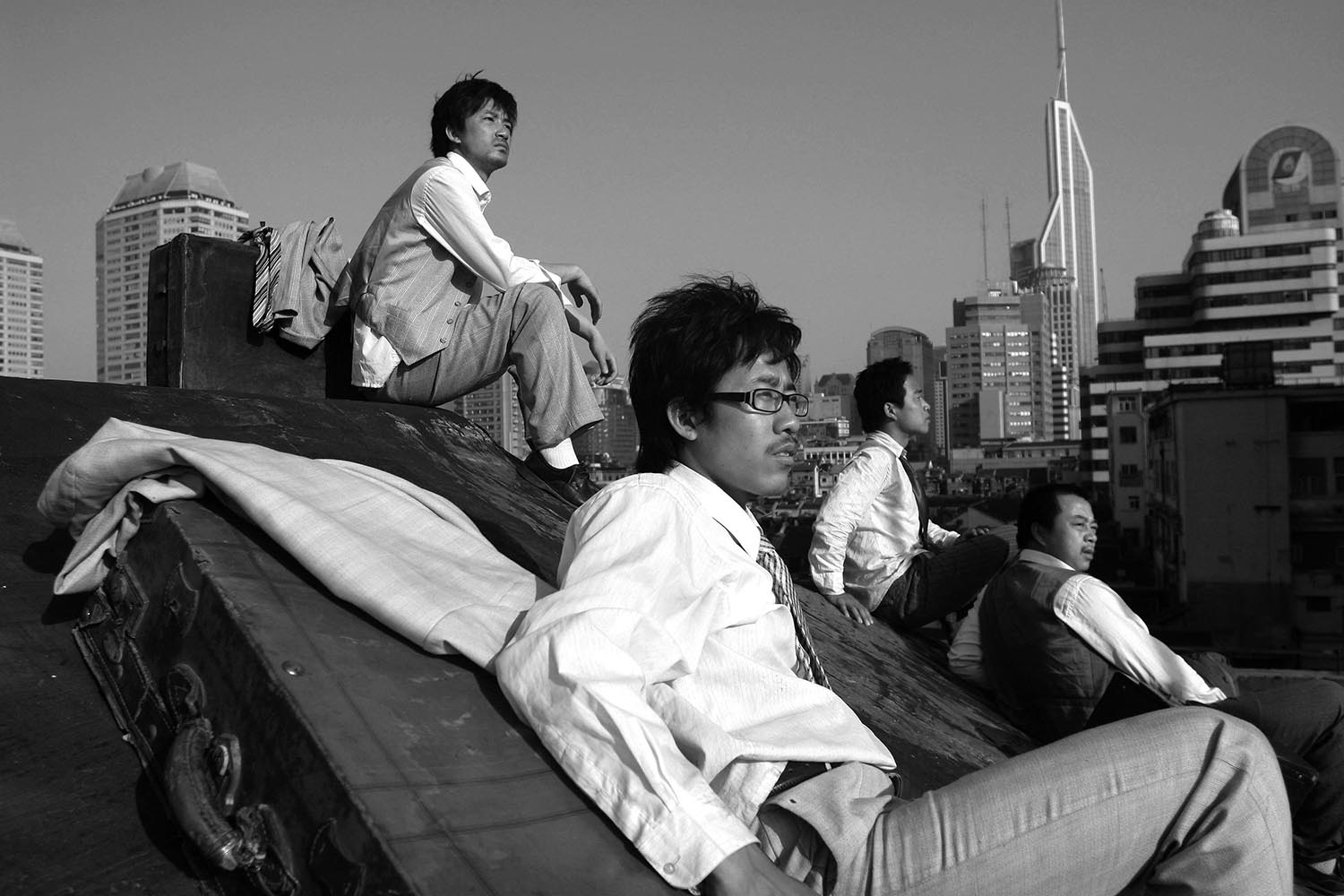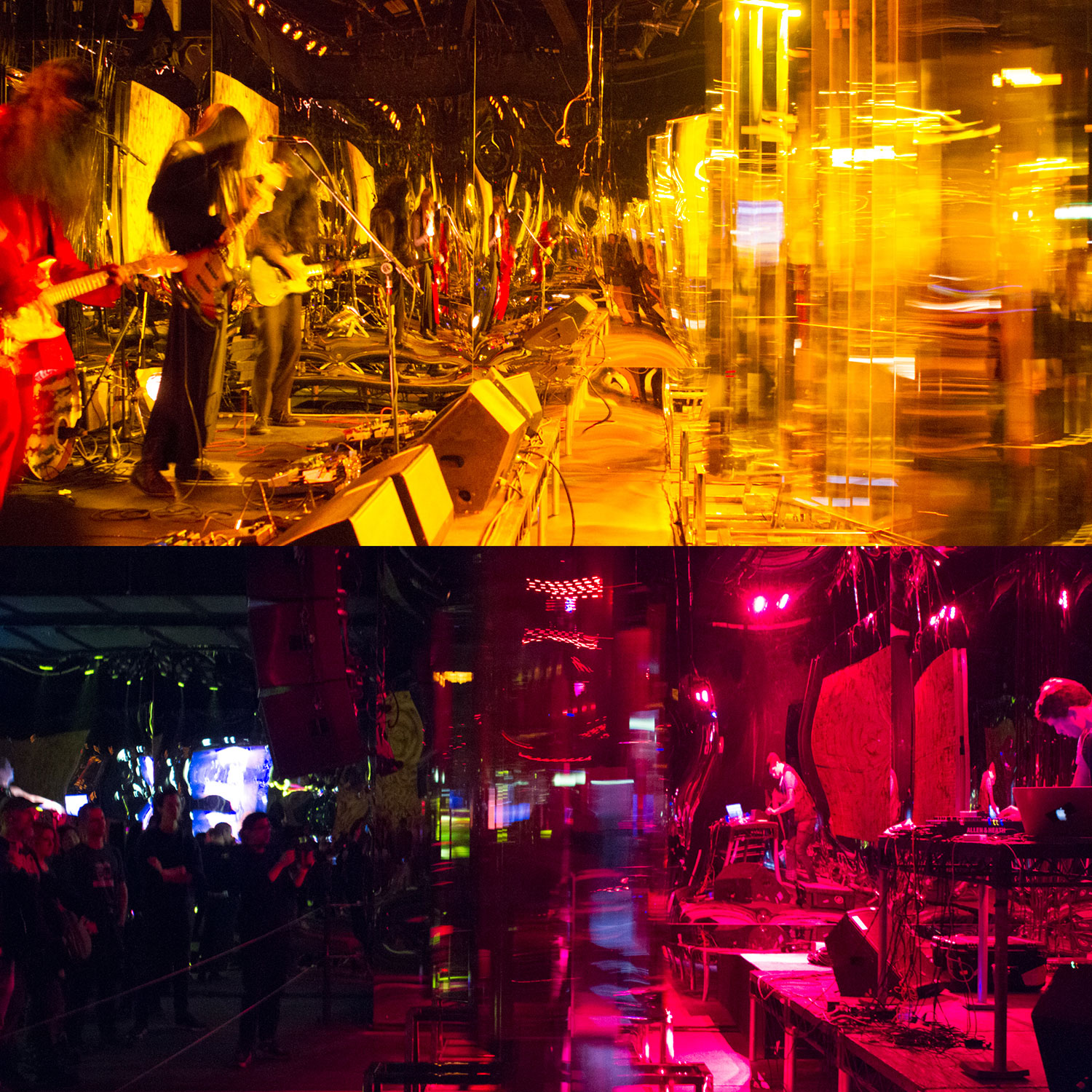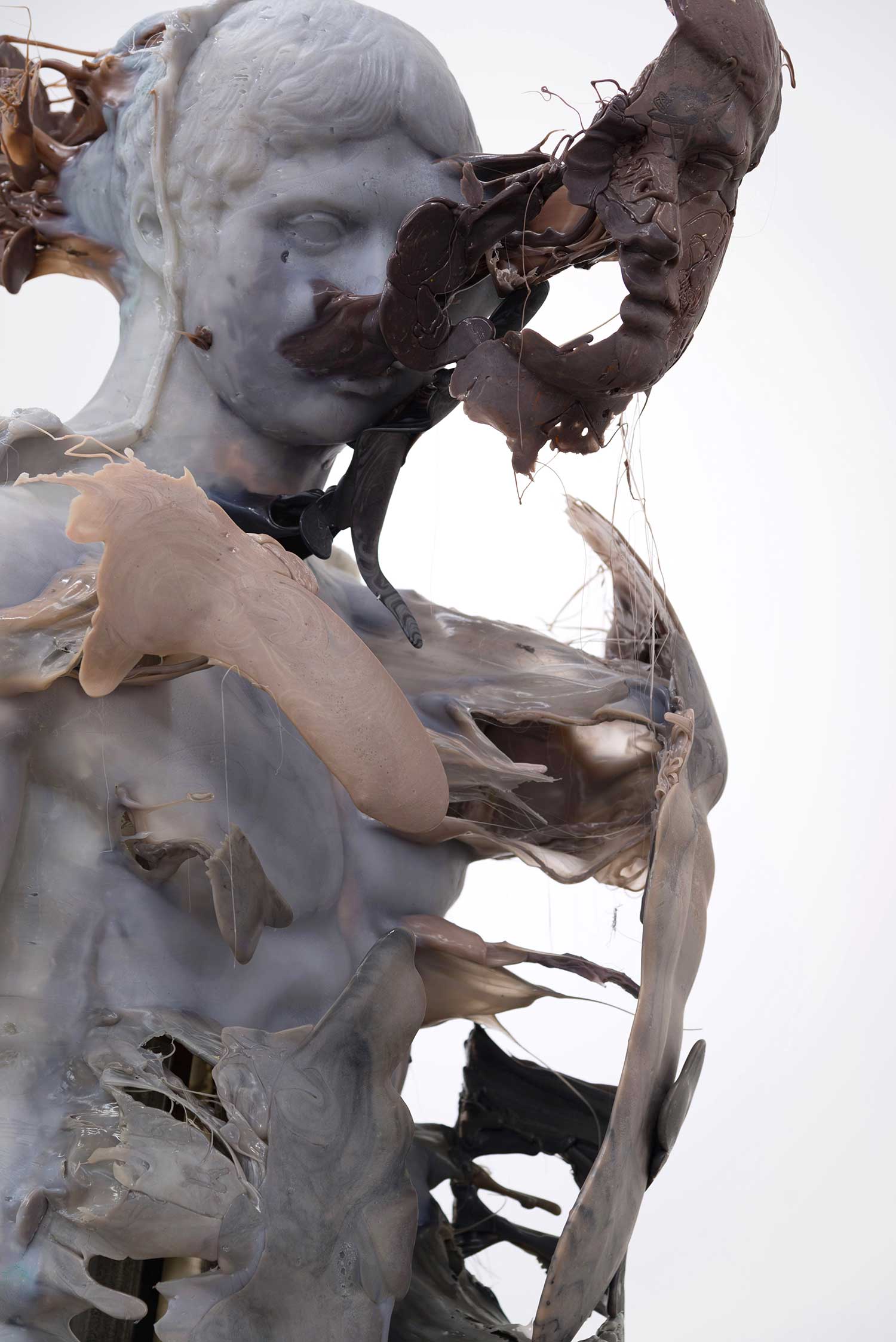
New media art has a relatively short history in Greater China, where more traditional forms such as painting and sculpture have tended to hold sway. So-called “new media” artworks have included re-engineered video games, sound art and interactive video installations. Recently, however, artists such as Shanghai-born Lu Yang have been breaking new ground; aesthetic coding and biological art are only some of the strategies deployed in new media art practices. Here, Francesca Tarocco talks with Lu Yang and media art experts Stephanie DeBoer and Ingrid Fischer-Schreiber, in the attempt of putting together an account of the development of new media art in Shanghai.
Francesca Tarocco: Lu Yang, what do you think were the initial factors leading to China’s embrace of new media art — and particularly in Shanghai?
Lu Yang: I’m not quite sure about the answer, but it probably had to do with the efforts of a relatively small number of people working in university departments, as well as the influence of art curators. Also the work of foreign artists who were already active in this field. As for me, I loved this kind of stuff since I was a child. My department [Lu is a graduate of the New Media Art Department of the China Academy of Art in Hangzhou] had some great teachers, such Yao Dajun [a sound artists and curator who runs the Open Media Lab of the China Academy of Art] and Zhang Peili [a pioneer of video art in China]. They helped me and encouraged me to develop my interests. That said, my own art practice doesn’t have much to do with any particular teaching or institution.
FT: Stephanie, you said that at the beginning of the New Media Art Department, in the early 2000s, there was no one dealing with digital art as it is understood today.
Stephanie DeBoer: Yes, the beauty of that first class, at least as reflected upon by colleagues with whom I’ve spoken about it, was that it didn’t really direct its students in the ways that the studio formation does now. The interdisciplinary approach allowed students to go where they wanted, and to expand beyond the already ambiguous boundaries of “new media art.”
FT: Lu Yang, I remember seeing some of your trailblazing works in Shanghai in 2009 and 2010. In that year you received your MA and had your first solo show in Shanghai, “Lu Yang Hell” [at Art Labor, Shanghai]. Later on, in 2013, you showed Uterus Man, wherein the eponymous anime-style genderless character rides a “pelvis chariot” and skateboards on a winged sanitary pad. There was a kind of “video game” installation work, but you also made use of technical drawings and 3-D animations. You have said that, growing up in Shanghai, television channels used to show Japanese anime. Anime aesthetics, cyborgs and more universal questions on the nature of self are important to you…
LY: Yes. For example, I had this idea [of Uterus Man] around 2012 and started working on this project non-stop. It gradually developed into a video game. Whether it is a work of animation or a video game, similar to my other works, is just a matter of how I package it in order to present it to the audience. Games and animations are certainly great sources of inspiration for me — they also make me live in a virtual world and escape reality. In my most recent work, Lu Yang Delusional Mandala (2015), I show a digital human simulator in my own shape. The core of the entire series is a contemplation of self-destruction and whether I really exist. It is more of a Buddhist Sadhana, a self-transcending spiritual practice, than an “artwork.” Or even more of a reflection on what we call “matter” and “life” than a self-reflection. Right now, I’m thinking about doing another work within this series — as an artist’s reflection on my creation in the past, present and future…

FT: It’s a kind of transhumanism and futurology. But, stepping back for a moment, I have always thought that disconnected temporalities, time loops and delocalization play a role in the choice of media among Shanghai-based artists. The works can never be exactly replicated, and no viewer can ever have the same encounter with the work more than once. This is due, in part, to the unpredictable effects of time on viewers’ perception and memory. Video art and screen based-work were incredibly important in the Shanghai art ecosystem of the 1990s. I am thinking of some of the works I saw then. In 1996, Shanghai-based artist Qian Weikang made his last video work, Breathing, Breathing, in which the repeated sound of a toilet flushing breaks up footage of TV commercials, of street scenes full of advertisements, and of the artist’s friends gathering for parties and other social events. Several artists at the time were using video art to talk about what was going on in Shanghai, in urban China and the rest of East Asia.
SDB: If we consider the genealogies of media art — the practices that came before the late 1990s and early 2000s when the term “media art” became a category for institutions, funding and arts practices — video art is one important strain to understand. Zhang Peili’s work is, of course, absolutely central here. But when we consider the work of other artists and media-makers, we also need to think of other strains. Some of Feng Mengbo’s work, for example, might be linked to a history of video art given his uses of screens. Yet full understanding also requires a cognizance of the distinct histories of, say, video games, as articulated both in China and elsewhere.
FT: Arcades and US and Japanese coin-operated games came to China in the 1980s. PCs were first adopted in the mid-1980s; the Internet debuted in 1986; the mobile phone first went into service in 1987; and China’s first blog was posted on the Internet in 2002. New media technologies are transforming the media landscape in China just like elsewhere, ushering in a paradigm shift in mass communications.
LY: I think it depends on individual works. As for me, I really enjoy doing stuff with computers, even if I think this is a pretty lazy way to work. Others may think that my digital work involves a lot of complex programming, but I mostly do things by myself and can realize my projects using only a few computers. That way I can avoid having to work with others, and I can fully immerse myself in the creative process. Yet, to me, from a metaphysical point of view, the world is an illusion, isn’t it? It’s composed of light and atoms… New media works and object-based works do not differ so much, essentially. I was subconsciously influenced by so many things I saw growing up in Shanghai. Today, I read books on psychology, neuroscience experiments and religion, like Life is a Theatre by Bhutanese lama Khyentse Norbu. And I like animations such as Knights of Sidonia and Ajin: Demi-Human.
SDB: This is not to mention the modes of media art that respond to trajectories other than that of the screen — robotics and electric circuitry, mobile networking and the Internet, sound and audio, performance and public art, to name only a few. If I think about video art in China, Zhang Ga’s exhibition of international media artists in Shanghai in 2009 [“eArts Beyond” at Shanghai eArts Festival] and indeed the wide range of practices we see today make it clear that video art, as it shifts from analog to digital form and politics, is but one of many articulations included in the category of “media art.” I wouldn’t say that video art can or even should be simply reduced under the category of “media art” — other cinema, film or documentary traditions are also important to its formation and expression. Linda Lai has been doing some great work on the history and development of video art in Hong Kong. As she traces its development in Hong Kong from the mid-1980s, she finds it important to confront the range of practices that overlap with this thing called video art — all these things variously labeled and understood to be independent film, documentary, media art and so on. Attending to this kind of naming is significant, because it indicates a range of practices and players — from the aesthetic to the political — that gets included or disregarded in the conversation.

FT: Let’s think about some of the players in China. Ingrid, what about the role of Ars Electronica? You were active with Ars Electronica in both Shanghai and Beijing in the 2000s. Can you tell us about some of the institutional efforts? In 2006, the newly appointed director of the National Museum of China, Fan Di’an, approached Zhang Ga to curate a major exhibition of media art as part of the Olympic cultural program to signal a significant shift in the museum’s curatorial philosophy. In 2008, in the lead up to the Olympics, it unveiled “Synthetic Times,” a major survey of global media art practice, again curated by Zhang Ga.
Ingrid Fischer-Schreiber: Yes, in fact it seems to me that in Beijing, it was all really about Zhang Ga, a New York–based Chinese independent curator educated in the US and Germany. He was responsible for introducing new media art practices and artists to Chinese audiences. In 2004, Zhang Ga was nominated artistic director of the First Beijing International New Media Arts Exhibition and Symposium, a two-year-long project he initiated and co-organized with Lu Xiaobo, vice dean of the Academy of Arts and Design at Tsinghua University. He put together the first big new media art shows in Beijing in 2004 to 2006: the first and second Beijing International New Media Art Exhibition and Symposium. I think this was the first big event dedicated to media art in China. Among the organizers were ZKM Center for Art and Media, Karlsruhe, and V2_ Institute for the Unstable Media, Rotterdam. I was there at the Symposium in 2004 as representative of Ars Electronica. And Feng Mengbo was certainly there — he had received an Award of Distinction in Interactive Art at Prix Ars Electronica in 2004 for his work Ah_Q – A Mirror of Death. In retrospect, Zhang Ga was lucky to find a supporting mentor in Lu Xiaobo. At the same time, Western institutions that were eager to get into China were quite happy to offer funding, support and conceptual frameworks.
FT: What about Shanghai?
IFS: In 2006, Ars Electronica was invited by the Shanghai Cultural Development Foundation to develop “Ars Electronica Shanghai.” The idea was to establish an institution similar to Ars Electronica, with a “museum,” a Futurelab (an R&D department), a festival and, sometime down the line, a competition like Prix Ars Electronica, adding some new projects based on the needs of the Chinese new media system. The vision was to develop Ars Electronica Shanghai into the leading Asian new media art institution (one step ahead of Beijing). The foundation did a very comprehensive feasibility study. There was already a timetable. Ars Electronica should have been the central contributor, but other institutions/curators would have been included. This festival should have built up momentum until 2010 and become one of the highlights of the EXPO year. In the end, the whole Ars Electronica Shanghai project was dropped. Ars Electronica ended up becoming the main partner for the eArts Festival in 2007.
FT: Very few of the artists involved were based in China.
IFS: Yes, many of the events I was involved with did not involve Chinese artists, except for the screen-based works by Zhang Peili and a few others. It was mostly “imported” media art.
FT: Stephanie, you are interested in putting together a spatial account of media arts projection, exhibition and development in Shanghai. Seen from your point of view, as a scholar working out these issues today, the terminology and practices surrounding the interface of art and technology were still quite unstable until very recently. Perhaps they still are?
SDB: Yes, and I think it is interesting to think of Shanghai as a platform whereby curators, artists and cultural workers discussed the possibilities and constraints of public spaces throughout the city through the eArts Festival. And they did so in negotiation with both local and global practices in video, media and technologically concerned art. What does it mean for Shanghai to be the locus of media arts development? The eArts Festival’s 2008 theme of “urbanized landscape” was conceived as a way to focus the festival on the particular concerns of Shanghai. This was not to program any simplistic notion of “Chinese new media art” per se, but was rather to curate a platform that could bring global media-art practices to Shanghai to sit in conversation with burgeoning developments in media art in China. Shanghai itself as a platform, if you will — a cityscape in which people were feeling, on an everyday and localized level, the intensities of increasingly rapid and not unproblematic shifts in urbanization, technologization, state power and globalization.

FT: Lu Yang, what about new media art today?
LY: Oh, but what is “new media”? Technology? How many artists can get their hands on the latest and most advanced technology? I think what matters the most is what is the core of a work. Only the core. Media is just a glamorous box in which artists pack their works. I hope to see more individual concepts from new media artists in China instead of a bunch of artifacts which may seem cool to the public but are like garbage to the real scientists and tech communities.
FT: Well, yes, there has been a very pragmatic approach to technology in the past decades, with cloning and all the rest, but also much creativity. Ingrid, I know that you are interested in the rapid, flexible and open ecosystem called shanzhai. Since 2010, the shanzhai ecology has moved beyond cloning exisisting technology and enabled a wealth of iterative innovations.
IFS: Yes, I am interested in the shanzhai ecosystem with its indigenous “open source” culture (gongban “public board” / gongmo “public case”). Most of it happened in Shenzhen, a large southern city that borders Hong Kong, but its products, whether knock-offs or inventions, have spread throughout urban China, from Canton to Shanghai and beyond. It has been incredibly influential for artists as well. I am now a bit skeptical as to what will happen next to the small local shanzhai companies. They may become more and more irrelevant given the new economic environment: Chinese are “richer,” so that they can afford branded products. Chinese companies like Xiaomi and their cheap products — which are, up to a point, shanzhai — are eating a big part of the former shanzhai market.
FT: Stephanie, you are a scholar-in-residence at Shanghai’s Chronus Art Center, China’s first non-profit art organization dedicated to new media’s presentation, creation and research. Its founder, Dillion Zhang, is an entrepreneur; Ingrid and the curators Li Zhenhua and Zhang Ga have all been involved with it, as well as the artist Hu Jieming, who was something of an early adopter of new technologies in Shanghai.
SDB: Yes, Hu Jieming’s Overture and Tai Chi, recently exhibited at the Chronus Art Center, is an interesting case here. Overture (2014) consists of tiny projected screens that can be peeked in upon by looking through gaps and small holes along a rough brick wall along the interior edges of a darkened gallery space. It shifts our viewing from large-scale film or video viewing to the small screen — ubiquitous in contemporary urban life. Indeed, we might say that this aspect of the work speaks to a lineage of not simply video viewing, but also to the intricacies of urban, even Shanghai viewing — viewing linked to peephole glances at neighbors and passersby beyond the wall that surround us, or at least that have surrounded many neighborhoods. Yet the exhibit transformed into Tai Chi (2014), as a skeletal framework controlled by motors worked to slowly walk around the space. In this iteration of the work, the video left behind the bricks became embedded into the boned structure of the machine, projecting their visions out onto its body and onto the surfaces of the room around it. To understand this element of the work is to go back to a history of interactive and computing technology, to the intersections between engineering, software and the body. Much of this resonates with media arts linked to those displayed in Zhang Ga’s 2009 exhibition that I mentioned earlier, and to work done at the China Academy of Art in Hangzhou. And much of it extends beyond it. It is very hard — and probably not even advisable — to overly “discipline” the fields of media art.





